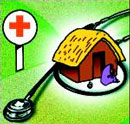01 November 2011
By Kounteya Sinha
New Delhi, India

On October 19, Union health minister Ghulam Nabi Azad gave the Medical Council of India (MCI) a three-week deadline to endorse this new course, failing which the ministry will issue a directive to the MCI to recognize and roll out the course.
Azad told TOI that the course enjoys the backing of all state governments, and blamed an apathetic MCI for the tardiness.
“We have made up our mind to introduce the Bachelor of Rural Medicine (BRM) degree. Sometimes the MCI gets influenced by its own fraternity. With doctors unwilling to serve in rural areas, even after being given incentives, we are left with no choice but to introduce a new cadre of health workers,” Azad told TOI.
He added “We want an MCI stamp on the degree to make it universally recognized. The syllabus of the course is ready and it is need based. If MCI endorses it, students will get the confidence that the degree has a standing. If MCI does not agree, we will send them a directive that it has to adhere to.”
Union health secretary P K Pradhan said “The degree-holders will be rural public health officers and will look after primary and preventive healthcare. However, they won’t carry out surgeries.” Pradhan endorsed the plan that all new BRM cadre would be given a career progression incentive, and they would be promoted to public health officers after serving for 10 years.
India is facing an acute shortage of human resources in health – the sting of which is being faced by the flagship National Rural Health Mission, and the vulnerable population in rural, tribal and hilly areas is extremely underserved.
In 2006, only 26% of doctors in India lived in rural areas, serving 72% of the population. Another study found the urban density of doctors is about four times that in rural areas, and that of nurses about three times higher. As of March, 2010, undue delays in recruitments resulted in vacancies even in available posts at health centres. Over 34% of male health workers, 38% of radiographers, 16% of laboratory technicians, 31% of specialists, 20% of pharmacists and 17% of ANMs and 10% of doctors’ posts were lying vacant.
Overall, human resources in health shortfalls range from 63% for specialists to 10% for allopathic doctors.
The BRM also got the backing of the Planning Commission’s high level expert group (HLEG) on universal health coverage. The panel said, by 2022 India should have BRMC colleges in all districts that have a population of over 5 lakh.
It suggested that the course should focus on “high quality of competence in preventive, promotive and rehabilitative services required for rural populations with focus on primary healthcare.” It recommended that course should be mandated through legislation that a graduate of the BRHC programme is licenced to serve only in notified areas in the government health system.
The panel, however, made it clear that the BRMS would be a unique training programme aimed at the basic healthcare needs of its target population.
The number of allopathic doctors registered with the MCI has increased since 1974 to 6.12 lakhs .
Disclaimer: The news story on this page is the copyright of the cited publication. This has been reproduced here for visitors to review, comment on and discuss. This is in keeping with the principle of ‘Fair dealing’ or ‘Fair use’. Visitors may click on the publication name, in the news story, to visit the original article as it appears on the publication’s website.